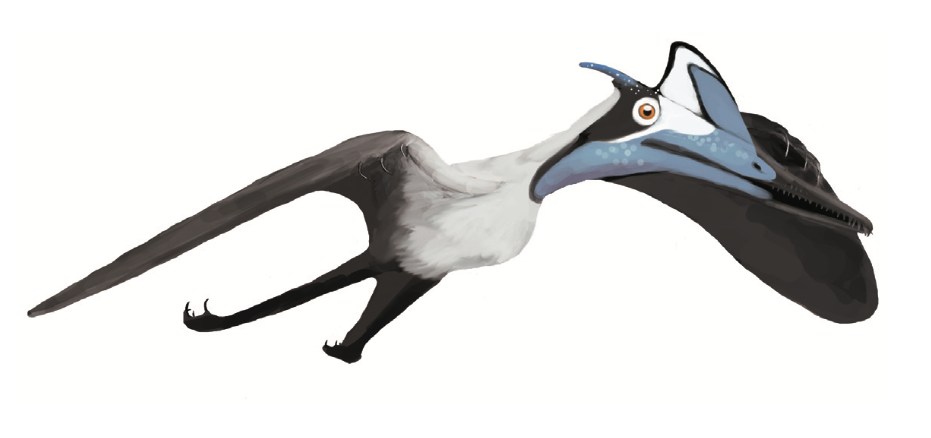|
Caelidracones
The Caelidracones is a group of pterosaurs. The clade Caelidracones was defined in 2003 by David Unwin as the group consisting of the last common ancestor of ''Anurognathus ammoni'' and '' Quetzalcoatlus northropi'', and all its descendants. The name Caelidracones means "sky dragons" from Latin ''caelum'', "heaven", and ''draco'', "dragon" and is a reference to Harry Govier Seeley's 1901 book, ''Dragons of the Air''. Classification In Unwin's original classification, the Caelidracones were considered the sister group of the Dimorphodontidae within the Macronychoptera and consist of the Anurognathidae and the Lonchognatha. More recent studies of pterosaur relationships have found anurognathids and pterodactyloids to be sister groups, which would limit Caelidracones to just those two clades. Below is a cladogram showing the results of a phylogenetic analysis presented by Longrich, Martill, and Andres, 2018. This study found the two traditional groupings of ctenochasmatoids ... [...More Info...] [...Related Items...] OR: [Wikipedia] [Google] [Baidu] |
Lonchognatha
Novialoidea (meaning "new wings") is an extinct clade of macronychopteran pterosaurs that lived from the latest Early Jurassic to the latest Late Cretaceous (early Toarcian to late Maastrichtian ageBarrett, P. M., Butler, R. J., Edwards, N. P., & Milner, A. R. (2008). Pterosaur distribution in time and space: an atlas. ''Zitteliana'', 61-107/ref>), their fossils having been found on all continents except Antarctica. History and classification Novialoidea was named by paleontologist Alexander Wilhelm Armin Kellner in 2003 as a node-based taxon consisting of the last common ancestor of ''Campylognathoides'', '' Quetzalcoatlus'' and all its descendants. This name was derived from Latin ''novus'' "new", and ''ala'', "wing", in reference to the wing synapomorphies that the members of the clade possess.Kellner, A. W. A., (2003): Pterosaur phylogeny and comments on the evolutionary history of the group. pp. 105-137. — ''in'' Buffetaut, E. & Mazin, J.-M., (eds.): ''Evolution an ... [...More Info...] [...Related Items...] OR: [Wikipedia] [Google] [Baidu] |
Pterodactyloidea
Pterodactyloidea (derived from the Greek words ''πτερόν'' (''pterón'', for usual ''ptéryx'') "wing", and ''δάκτυλος'' (''dáktylos'') "finger" meaning "winged finger", "wing-finger" or "finger-wing") is one of the two traditional suborders of pterosaurs ("wing lizards"), and contains the most derived members of this group of flying reptiles. They appeared during the middle Jurassic Period, and differ from the basal (though paraphyletic) rhamphorhynchoids by their short tails and long wing metacarpals (hand bones). The most advanced forms also lack teeth, and by the late Cretaceous, all known pterodactyloids were toothless. Many species had well-developed crests on the skull, a form of display taken to extremes in giant-crested forms like ''Nyctosaurus'' and ''Tupandactylus''. Pterodactyloids were the last surviving pterosaurs when the order became extinct at the end of the Cretaceous Period, together with the non-avian dinosaurs and most marine reptiles. "Pteroda ... [...More Info...] [...Related Items...] OR: [Wikipedia] [Google] [Baidu] |
Kryptodrakon
''Kryptodrakon'' is an extinct genus of pterodactyloid pterosaur from the Middle to Late Jurassic with an age of approximately 162.7 million years. It is known from a single type species, ''Kryptodrakon progenitor''. The age of its fossil remains made ''Kryptodrakon'' the basalmost and oldest pterodactyloid known to date. Discovery and naming In 2001, pterosaur bones were discovered in Xinjiang by Chris Sloan. The bones were first identified as those of a theropod; paleontologist James Clark later recognized their pterosaurian nature. In 2014, Brian Andres, Clark and Xu Xing named and described the type species ''Kryptodrakon progenitor''. The generic name means ''hidden dragon'' from Greek κρυπτός, ''kryptos'' (''hidden''), and δράκων, ''drakon'' (''dragon''). The name alludes to the film ''Crouching Tiger, Hidden Dragon,'' which included some scenes filmed near the type locality. The specific name ''progenitor'' means ''ancestor'' or ''founder of a family'' in ... [...More Info...] [...Related Items...] OR: [Wikipedia] [Google] [Baidu] |
Lophocratia
Pterodactyloidea (derived from the Greek words ''πτερόν'' (''pterón'', for usual ''ptéryx'') "wing", and ''δάκτυλος'' (''dáktylos'') "finger" meaning "winged finger", "wing-finger" or "finger-wing") is one of the two traditional suborders of pterosaurs ("wing lizards"), and contains the most derived members of this group of flying reptiles. They appeared during the middle Jurassic Period, and differ from the basal (though paraphyletic) rhamphorhynchoids by their short tails and long wing metacarpals (hand bones). The most advanced forms also lack teeth, and by the late Cretaceous, all known pterodactyloids were toothless. Many species had well-developed crests on the skull, a form of display taken to extremes in giant-crested forms like ''Nyctosaurus'' and ''Tupandactylus''. Pterodactyloids were the last surviving pterosaurs when the order became extinct at the end of the Cretaceous Period, together with the non-avian dinosaurs and most marine reptiles. "Pterod ... [...More Info...] [...Related Items...] OR: [Wikipedia] [Google] [Baidu] |
Macronychoptera
Pterosaurs (; from Greek ''pteron'' and ''sauros'', meaning "wing lizard") is an extinct clade of flying reptiles in the order, Pterosauria. They existed during most of the Mesozoic: from the Late Triassic to the end of the Cretaceous (228 to 66 million years ago). Pterosaurs are the earliest vertebrates known to have evolved powered flight. Their wings were formed by a membrane of skin, muscle, and other tissues stretching from the ankles to a dramatically lengthened fourth finger. There were two major types of pterosaurs. Basal pterosaurs (also called 'non-pterodactyloid pterosaurs' or 'rhamphorhynchoids') were smaller animals with fully toothed jaws and, typically, long tails. Their wide wing membranes probably included and connected the hind legs. On the ground, they would have had an awkward sprawling posture, but the anatomy of their joints and strong claws would have made them effective climbers, and some may have even lived in trees. Basal pterosaurs were insectivo ... [...More Info...] [...Related Items...] OR: [Wikipedia] [Google] [Baidu] |
Pterosaurs
Pterosaurs (; from Greek ''pteron'' and ''sauros'', meaning "wing lizard") is an extinct clade of flying reptiles in the order, Pterosauria. They existed during most of the Mesozoic: from the Late Triassic to the end of the Cretaceous (228 to 66 million years ago). Pterosaurs are the earliest vertebrates known to have evolved powered flight. Their wings were formed by a membrane of skin, muscle, and other tissues stretching from the ankles to a dramatically lengthened fourth finger. There were two major types of pterosaurs. Basal pterosaurs (also called 'non-pterodactyloid pterosaurs' or 'rhamphorhynchoids') were smaller animals with fully toothed jaws and, typically, long tails. Their wide wing membranes probably included and connected the hind legs. On the ground, they would have had an awkward sprawling posture, but the anatomy of their joints and strong claws would have made them effective climbers, and some may have even lived in trees. Basal pterosaurs were insectiv ... [...More Info...] [...Related Items...] OR: [Wikipedia] [Google] [Baidu] |
Pterodactylus
''Pterodactylus'' (from Greek () meaning 'winged finger') is an extinct genus of pterosaurs. It is thought to contain only a single species, ''Pterodactylus antiquus'', which was the first pterosaur to be named and identified as a flying reptile. Fossil remains of ''Pterodactylus'' have primarily been found in the Solnhofen limestone of Bavaria, Germany, which dates from the Late Jurassic period (early Tithonian stage), about 150.8 to 148.5 million years ago. More fragmentary remains of ''Pterodactylus'' have tentatively been identified from elsewhere in Europe and in Africa. ''Pterodactylus'' was a generalist carnivore that probably fed on a variety of invertebrates and vertebrates. Like all pterosaurs, ''Pterodactylus'' had wings formed by a skin and muscle membrane stretching from its elongated fourth finger to its hind limbs. It was supported internally by collagen fibres and externally by keratinous ridges. ''Pterodactylus'' was a small pterosaur compared to other famo ... [...More Info...] [...Related Items...] OR: [Wikipedia] [Google] [Baidu] |
Pterodactylus BMMS7 Life
''Pterodactylus'' (from Greek () meaning 'winged finger') is an extinct genus of pterosaurs. It is thought to contain only a single species, ''Pterodactylus antiquus'', which was the first pterosaur to be named and identified as a flying reptile. Fossil remains of ''Pterodactylus'' have primarily been found in the Solnhofen limestone of Bavaria, Germany, which dates from the Late Jurassic period (early Tithonian stage), about 150.8 to 148.5 million years ago. More fragmentary remains of ''Pterodactylus'' have tentatively been identified from elsewhere in Europe and in Africa. ''Pterodactylus'' was a generalist carnivore that probably fed on a variety of invertebrates and vertebrates. Like all pterosaurs, ''Pterodactylus'' had wings formed by a skin and muscle membrane stretching from its elongated fourth finger to its hind limbs. It was supported internally by collagen fibres and externally by keratinous ridges. ''Pterodactylus'' was a small pterosaur compared to other famous ... [...More Info...] [...Related Items...] OR: [Wikipedia] [Google] [Baidu] |
Germanodactylidae
Germanodactylidae is a controversial group of pterosaurs within the suborder Pterodactyloidea. It was first named by Yang Zhongjian in 1964, and given a formal phylogenetic definition in 2014 by Brian Andres, James Clark, and Xu Xing. They defined it as the least inclusive clade containing ''Germanodactylus cristatus'' and ''Normannognathus wellnhoferi'', which they considered to be close relatives at the time. However, more recent studies by the same researchers have found that these pterosaurs may be only distantly related. Studies performed in the 2000s suggested this group it contained three genera: ''Germanodactylus'', '' Normannognathus'' and ''Tendaguripterus''. Various studies have since placed these pterosaurs within the larger clades Archaeopterodactyloidea, Eupterodactyloidea, or Dsungaripteroidea, though it has also been recovered within the Ctenochasmatoidea. In several 2010s studies, the supposed "germanodactylid" species were not necessarily found to form a natur ... [...More Info...] [...Related Items...] OR: [Wikipedia] [Google] [Baidu] |
Altmuehlopterus DB
''Altmuehlopterus'' (meaning "Altmühl River wing") is a genus of pterosaur belonging to the Pterodactyloidea. It lived in the Late Jurassic of what is now Germany. It was formerly known as "Daitingopterus" (meaning "Daiting Wing"), a ''nomen nudum'', informally coined in 2004. Discovery and naming In 1851, Johann Andreas Wagner named a new species of ''Ornithocephalus'' (a now-obsolete name for the genus '' Pterodactylus''), ''Ornithocephalus ramphastinus''. The specific name referred to the toucan genus '' Ramphastos'', in view of the large beak-like snout of the pterosaur. In 1859/1860, Christian Erich Hermann von Meyer corrected the specific name to ''rhamphastinus''. Although this was incorrect by modern standards, the new spelling has become valid by being accepted and used by subsequent authors, under article ICZN 33.3.1. The holotype, BSP AS.I.745, was probably found at Mörnsheim near Daiting in a layer of the '' Malm Zeta 3'', dating from the Tithonian. It cons ... [...More Info...] [...Related Items...] OR: [Wikipedia] [Google] [Baidu] |
Euctenochasmatia
Euctenochasmatia is an extinct group of pterodactyloid pterosaurs. It was named by David Unwin in 2003 as the group that contains the most recent common ancestor of ''Pterodactylus'' and ''Ctenochasma'', and all their descendants. Euctenochasmatians were specialized pterosaurs that had elongated necks as well as specialized teeth. A peculiar family within this group is the Ctenochasmatidae, which most of the members had very distinguishing teeth that were lined within their elongated snouts. A genus called ''Pterofiltrus'' only had 112 teeth, but these teeth cover about 55.8% of the total skull, and the skull itself measured about in length. Description Euctenochasmatians had very distinctive features in comparison to other pterosaurs, including the shape of their jaws, as well as their highly specialized teeth. These teeth are thought to have been used for filter-feeding, the genus ''Pterodaustro'' for example, had a long snout and its lower jaws curve strongly upwards, and th ... [...More Info...] [...Related Items...] OR: [Wikipedia] [Google] [Baidu] |
Archaeopterodactyloidea
Archaeopterodactyloidea (meaning "ancient Pterodactyloidea") is an extinct clade of pterodactyloid pterosaurs that lived from the middle Late Jurassic to the latest Early Cretaceous periods (Kimmeridgian to Albian stages) of Africa, Asia, Europe and North America. It was named by Alexander Wilhelm Armin Kellner in 1996 as the group that contains ''Germanodactylus'', ''Pterodactylus'', the Ctenochasmatidae and the Gallodactylidae. In 2003, Kellner defined the clade as a node-based taxon consisting of the last common ancestor of ''Pterodactylus'', ''Ctenochasma'' and ''Gallodactylus'' and all its descendants. Although phylogenetic analyses that based on David Unwin's 2003 analysis do not recover monophyletic Archaeopterodactyloidea, phylogenetic analyses that based on Kellner's analyses, or the analyses of Brian Andres (2008, 2010, 2018) recover monophyletic Archaeopterodactyloidea at the base of the Pterodactyloidea. The Antarctic Campanian specimen MN 7801-V was referred to Archa ... [...More Info...] [...Related Items...] OR: [Wikipedia] [Google] [Baidu] |










